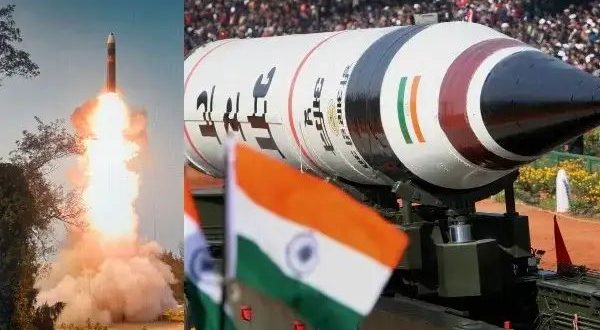India is continuously expanding its Strategic Forces Command (SFC), also known as the Strategic Nuclear Command. In the latest test, India has test-fired its new generation Agni-Prime ballistic missile, which has a range of 2,000 kilometres and will counter threats from Pakistan.
China follows a No First Use (NFU) policy regarding nuclear weapons, but it has clearly stated that NFU will be invalid if any country occupies its territory, or if any country occupies its land.
At the same time, Pakistan does not follow a strict no-first-use policy regarding nuclear weapons. Instead, it maintains the first use doctrine, which means that Pakistan can use nuclear bombs first against an opponent.
India masters missile technology
With Multiple Independently Targetable Re-entry Vehicle (MIRV) technology, India has tested the Agni-5 missile capability with a range of 6 thousand kilometers and it is believed that the Agni-5 missile has been tested keeping China in mind.
The Indian Defense Ministry has announced the successful test of the country’s new generation ballistic missile Agni-Prime from Dr. APJ Abdul Kalam Island off the Odisha coast. This test is the second pre-induction night launch of Agni-Prime. This missile will replace the previous generation Agni-II with a range of 700 kilometers.
As Indian scientists have increased the range of their missiles, technology has also expanded in the same way. Now efforts are being made to replace the old technology of missiles with more advanced technology.
Agni-P is India’s first short-range missile, which is equipped with technology like new Agni-IV and Agni-V ballistic systems such as advanced rocket motors, propellant, avionics and navigation systems.
Before Agni-P, India had tested another technology in Agni-V, which was not used in the previous variants of Agni and under this technology, the maintenance of this missile becomes very easy and it can be fired very fast.
What is canister technology?
Canisterization of missiles means storing missiles inside a sealed, climate-controlled tube to protect them from environmental elements during transport. This allows the missile to carry permanent warheads and does not need to be reassembled before launch. This helps reduce the time it takes to launch nuclear weapons in case of a crisis.
India first tested canister technology on Agni-V in 2015, after which India got the facility that now it can fire ballistic missiles at its enemy from anywhere, at any time.
Canister technology makes missiles transportable by road and missiles weighing more than 50 tonnes can not only be easily transported from one place to another by road, but can also be fired at a target while moving on the road.
Hitting multiple targets with one missile
In March, India successfully test-fired Agni-V, a long-range ballistic missile with Multiple Independently Targetable Re-entry Vehicle (MIRV) technology. This technology has given India a more flexible deterrence capability against its two aggressive nuclear-powered neighbours – China and Pakistan.
That is, with this technology, India can attack five different targets with a single missile. That is, in case of war, most of the enemy’s targets can be destroyed with a single missile, saving a lot of time.
With canister technology, India has been able to attack the entire territory of its neighbouring rival Pakistan in the west. Agni-V and submarine-launched ballistic missiles have been designed keeping in mind China, which is rapidly expanding its nuclear arsenal.
MIRV technology is also capable of penetrating ballistic missile defence shields, overpowering the air defence systems of opponents trying to stop multiple weapons. A MIRVed missile will be equipped with multiple warheads, allowing a single missile to attack several different targets simultaneously or a single target with multiple warheads. Such an arrangement would also make MIRVs difficult to intercept with anti-missile technology.
The MIRV technology of the Agni-V has been named ‘Divyastra’, and will be used in other Indian missiles going forward. The use of MIRVed missiles on submarines increases their survivability manifold, as nuclear submarines are difficult to detect.
The operational deployment of the 50-tonne Agni-V has enhanced India’s deterrence against China, which has missiles like the Dong Feng-41. With a range of 12,000-15,000 kilometres, the DF-41 missile can hit any Indian city. But now Agni-V has developed the capability to strike even the northernmost part of China, which shows how rapidly India is preparing against its enemies, so that the enemies cannot even dare to raise their eyes against the country.
 RB News World Latest News
RB News World Latest News






